- Wolfgang Pauli at the official Nobel Prize site
- Pauli bio at the University of St Andrews, Scotland
- Wolfgang Pauli bio at "Nobel Prize Winners"
- Wolfgang Pauli, Carl Jung and Marie-Louise von Franz
- Photos of Pauli at the American Institute of Physics
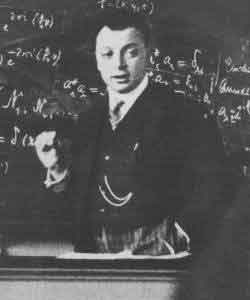
Wolfgang Pauli
Wolfgang Ernst Pauli (April 25, 1900 – December 15, 1958) was an Austrian-Swiss physicist noted for his work on the theory of spin.
Biography
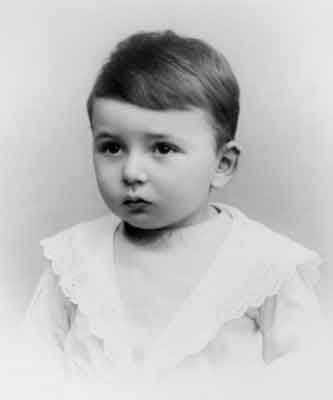
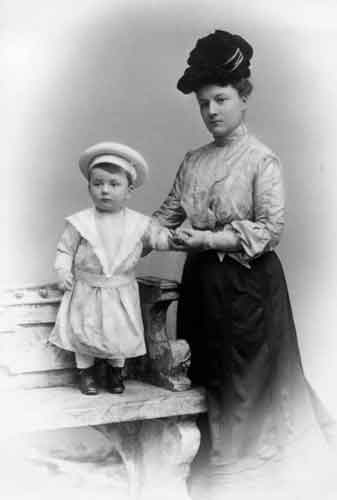
Pauli was born in Vienna to Wolfgang Joseph Pauli and Berta Camilla Schütz. His middle name was given in honor of his godfather, the physicist Ernst Mach.
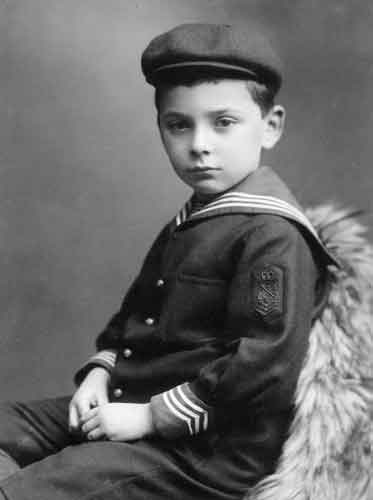
Pauli attended the Döblinger Gymnasium in Vienna, graduating with distinction in 1918. Only two months after graduation, the young prodigy had published his first paper, on Einstein's theory of general relativity. He attended the Ludwig-Maximilian University of Munich, working under Sommerfeld, where he received his doctorate in July 1921 for a thesis on the quantum theory of ionised molecular hydrogen.
Sommerfeld asked Pauli to review relativity for the Encyklopaedie der mathematischen Wissenschaften, a German encyclopedia. Two months after receiving his doctorate, Pauli completed the article, which came to 237 pages. It was praised by Einstein; published as a monograph, it remains a standard reference on the subject to this day.
He spent a year at the University of Göttingen as the assistant to Max Born, and the following year at what became the Niels Bohr Institute for Theoretical Physics in Copenhagen. He then spent 1923 to 1928 as a lecturer at the University of Hamburg. During this period, Pauli was instrumental in the development of the modern theory of quantum mechanics. In particular, he formulated the exclusion principle and the theory of nonrelativistic spin. (See below for a list of his scientific contributions.)
In May 1929, Pauli left the Roman Catholic Church; in December that year, he married Käthe Margarethe Deppner. The marriage was an unhappy one, ending in divorce in 1930 after less than a year.
At the beginning of 1931, shortly after his divorce and his immediately following postulation of the neutrino, Pauli had a severe breakdown. He consulted the psychiatrist and psychotherapist Carl Jung who lived like Pauli near Zurich. Pauli immediately began to interpret his deeply archetypal dreams and became one of the depth psychologist’s best students. Soon, he began to scientifically criticize the epistemology of Jung’s theory and contributed like this to a certain clarification of the latter’s thoughts, especially about the concept of synchronicity. A great deal of these discussions is documented in the Pauli/Jung letters, today published as “Atom and Archetype” (see below).
In 1928, he was appointed Professor of Theoretical Physics at the Federal Institute of Technology in Zurich, Switzerland. He held visiting professorships at the University of Michigan in 1931, and the Institute for Advanced Study at Princeton in 1935.
In 1934, he married Franca Bertram. This marriage would last for the rest of his life. They had no children.
The German annexation of Austria in 1938 made him a German citizen, which became a difficulty with the outbreak of the Second World War in 1939. Pauli moved to the United States in 1940, where he was Professor of Theoretical Physics at Princeton. After the end of the war, he became a naturalized citizen of the United States in 1946 before returning to Zurich, where he mostly remained for the rest of his life.
Also in 1945, he received the Nobel Prize in Physics for his "decisive contribution through his discovery in 1925 of a new law of Nature, the exclusion principle or Pauli principle." He had been nominated for the prize by Einstein.
In 1958, Pauli was awarded the Max Planck medal. In that same year, he fell ill with pancreatic cancer. When his last assistant, Charles Enz, visited him at the Rotkreuz hospital in Zurich, Pauli asked him: “Did you see the room number?” It was number 137. Throughout his life, Pauli had been preoccupied with the question of why the fine structure constant, a dimensionless fundamental constant, has a value nearly equal to 1/137. Pauli died in that room on December 15, 1958.
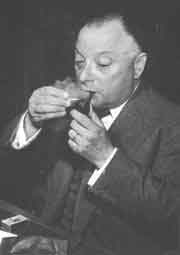
Wolfgang Pauli
Scientific career
Pauli made many important contributions in his career as a physicist, primarily in the subject of quantum mechanics. He seldom published papers, preferring lengthy correspondences with colleagues (such as Bohr and Heisenberg, with whom he had close friendships.) Many of his ideas and results were never published and appeared only in his letters, which were often copied and circulated by their recipients. Pauli was apparently unconcerned that much of his work thus went uncredited. The following are the most important results for which he has been credited:
In 1924, Pauli proposed a new quantum degree of freedom to resolve inconsistencies between observed molecular spectra and the developing theory of quantum mechanics. He formulated the Pauli exclusion principle, perhaps his most important work, which stated that no two electrons could exist in the same quantum state. Uhlenbeck and Goudsmit one year later identified this degree of freedom as electron spin.
In 1926, shortly after Heisenberg published the matrix theory of modern quantum mechanics, Pauli used it to derive the observed spectrum of the hydrogen atom. This result was important in securing credibility for Heisenberg's theory.
In 1927, he introduced the Pauli matrices as a basis of spin operators, thus solving the nonrelativistic theory of spin. This work influenced Dirac in his discovery of the Dirac equation for the relativistic electron.
In 1930 [letter of Dec 4 to the „Dear radioactive ladies and gentlemen" (Lise Meitner et al.)], he proposed the existence of a hitherto unobserved neutral and massless particle, in order to explain the continuous spectrum of beta decay. In 1934, Fermi incorporated the particle, which he called a neutrino, into his theory of radioactive decay. The neutrino was first observed experimentally in 1959.
In 1940, he proved the spin-statistics theorem, a critical result of quantum mechanics which states that particles with half-integer spin are fermions, while particles with integer spin are bosons.
Personality and reputation
The Pauli Effect was named after his bizarre ability to break experimental equipment simply by being in the vicinity. Pauli himself was aware of his reputation, and delighted whenever the Pauli Effect manifested.
Regarding physics, Pauli was famously perfectionist. This extended not just to his own work, but also to the work of his colleagues. As a result, he became known within the physics community as the "conscience of physics", the critic to whom his colleagues were accountable. He could be scathing in his dismissal of any theory he found lacking, often labelling it ganz falsch, utterly false. Famously, he once said of one such paper: "This isn't right. It isn't even wrong."
A well known joke about Pauli in the physics community goes as follows: After his death, Pauli was granted an audience with God. Pauli asked God why the fine structure constant has the value 1/(137.036...). God nodded, went to a blackboard, and began scribbling equations at a furious pace. Pauli watched Him with great satisfaction, but soon began shaking his head violently...
Related publications
- Enz, Charles, P. (2002): No Time to be Brief, A scientific biography of Wolfgang Pauli, Oxford Univ. Press.
- Enz, Charles, P. (1995): Rationales und Irrationales im Leben Wolfgang Paulis, in: Atmanspacher, H. et al (1995): Der Pauli-Jung-Dialog, Springer, Berlin.
- Pauli, W., Jung, C.G. (2001): Atom and Archetype, The Pauli/Jung Letters, 1932-1958, ed. C.A. Meier, Princeton, Univ. Press, Princeton, New Jersey.
- Lindorff, David (1994): Pauli and Jung: The Meeting of Two Great Minds, Quest Books.
Links
In 1906, Lenz graduated from the Klinger-Oberralschule, a non-classical secondary school in Frankfurt-am-Main, and went to study mathematics and physics at the University of Göttingen. From 1908 to 1911, Lenz studied under Arnold Sommerfeld, at the University of Munich, and he was granted his doctorate[3] on March 2, 1911. Upon graduation, he stayed on at the University, became Sommerfeld’s assistant on April 1, 1911, and he completed his Habilitation on February 20, 1914, becoming a Privatdozent on April 4, 1914. During World War I, he served as a radio operator in France and was awarded the Iron Cross Second Class in 1916. From September 30, 1920, he was again an assistant to Sommerfeld at the University of Munich’s Institute of Theoretical Physics, and he was appointed to the title and rank of extraordinarius professor at the University, on November 11, 1920. On December 1, 1920 he became an extraordinarius professor at the University of Rostock. From 1921, until his retirement in 1956, he was at the University of Hamburg, as Ordinarius Professor of Theoretical Physics and Director of the Institute of Theoretical Physics.[4] [5] [6] [7]
The formation of the new chair and institute for theoretical physics at Hamburg was a result of advances being made in Germany on atomic physics and quantum mechanics and the personal intervention of Sommerfeld, who helped many of his students get such professorships.[8]
At Hamburg, Lenz trained Ernst Ising and J. Hans D. Jensen; his assistants there included Wolfgang Pauli[9] Pascual Jordan,[10] and Albrecht Unsöld.[11] Together with Pauli and Otto Stern, Lenz built up the Institute into an international center for nuclear physics. They maintained close scientific and personal exchanges with the institutes for theoretical physics at the Universities in Munich (Sommerfeld), Göttingen (Max Born), and Copenhagen (Niels Bohr).[12] [13]
When Lenz retired in 1956 he was succeeded by Harry Lehmann.
Books
* Wilhelm Lenz Einführungsmathematik für Physiker (Verlagsanstalt Wolfenbüttel, 1947)
References
* Mehra, Jagdish, and Helmut Rechenberg The Historical Development of Quantum Theory. Volume 1 Part 1 The Quantum Theory of Planck, Einstein, Bohr and Sommerfeld 1900 – 1925: Its Foundation and the Rise of Its Difficulties. (Springer, 2001) ISBN 0-387-95174-1
* Mehra, Jagdish, and Helmut Rechenberg The Historical Development of Quantum Theory. Volume 1 Part 2 The Quantum Theory of Planck, Einstein, Bohr and Sommerfeld 1900 – 1925: Its Foundation and the Rise of Its Difficulties. (Springer, 2001) ISBN 0-387-95175-X
* Mehra, Jagdish, and Helmut Rechenberg The Historical Development of Quantum Theory. Volume 5 Erwin Schrödinger and the Rise of Wave Mechanics. Part 1 Schrödinger in Vienna and Zurich 1887-1925. (Springer, 2001) ISBN 0-387-95179-2
Notes
1. ^ Lenz, W (1920). "Beiträge zum Verständnis der magnetischen Eigenschaften in festen Körpern". Physikalische Zeitschrift 21: 613–615.
2. ^ Lenz, W (1924). "Über den Bewegungsverlauf und Quantenzustände der gestörten Keplerbewegung". Zeitschrift für Physik 24: 197–207.
3. ^ Lenz – Mathematics Genealogy Project. 1911 Dissertation title: Über das elektromagnetische Wechselfeld der Spulen und deren Wechselstrom-Widerstand, Selbstinduktion und Kapazität.
4. ^ Mehra, Volume 1, Part 1, p. 334.
5. ^ Author Catalog: Lenz – American Philosophical Society
6. ^ Lenz - ETH Zurich
7. ^ Lenz Biography – Litten
8. ^ Other examples besides Lenz at Hamburg, include Peter Debye at the University of Zurich, Adolf Kratzer at the University of Münster, and Erwin Fues at the University of Stuttgart, where Sommerfeld’s former student Paul Peter Ewald was already in place. When they were called to other facilities, these personnel effectively became extensions of Sommerfeld’s Institute of Theoretical Physics. See Mehra, Volume 1, Part 1, 1982, p. 335 and Mehra, Volume 5, Part 1, 2001, p. 249.
9. ^ Pauli began as Hilfsassistent to Lenz at Hamburg on April 1, 1922. He also completed his Habilitation there. Both Lenz and Otto Stern knew of Pauli’s abilities. The mathematician Erich Hecke was dean of the faculty at the time. Hecke waived the normal trail lecture and the colloquium for Habilitation, in recognition of his abilities. The "venia legendi" was conferred on Pauli and he gave his inaugural lecture on February 23, 1924. See Mehra, Volume 1, Part 2, pp. 487 and 672.
10. ^ In 1923, Jordan went to the University of Göttingen and was instrumental in helping Max Born in founding the matrix mechanics formulation of quantum mechanics in 1925, from a paper by Werner Heisenberg given to Born, in July of that year, for review and publication.
11. ^ Unsöld was a former doctoral student of Sommerfeld, who got his degree in 1927. See Unsöld – Mathematics Genealogy Project.
12. ^ Lenz Biography – Litten
13. ^ Lenz - ETH Zurich
Retrieved from "http://en.wikipedia.org/"
All text is available under the terms of the GNU Free Documentation License

